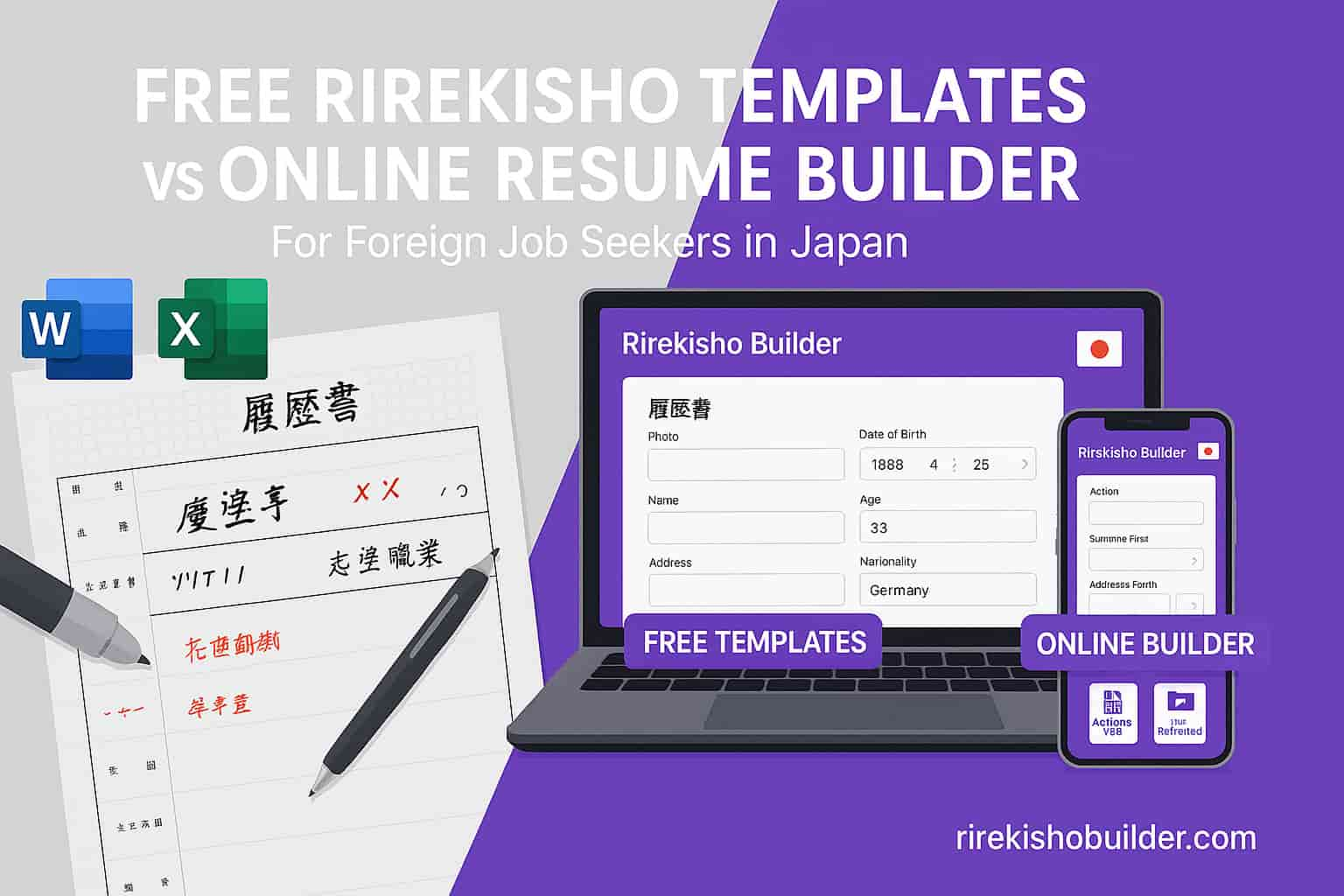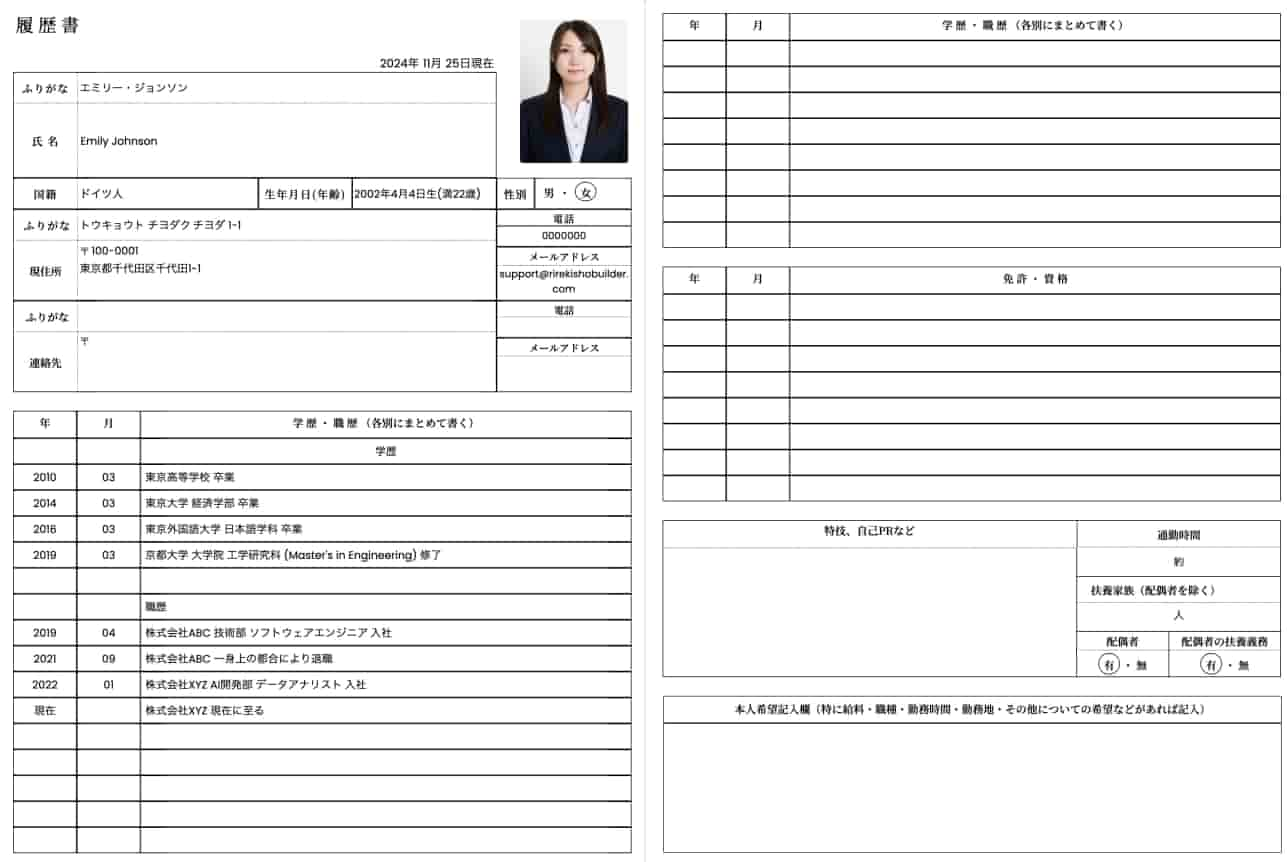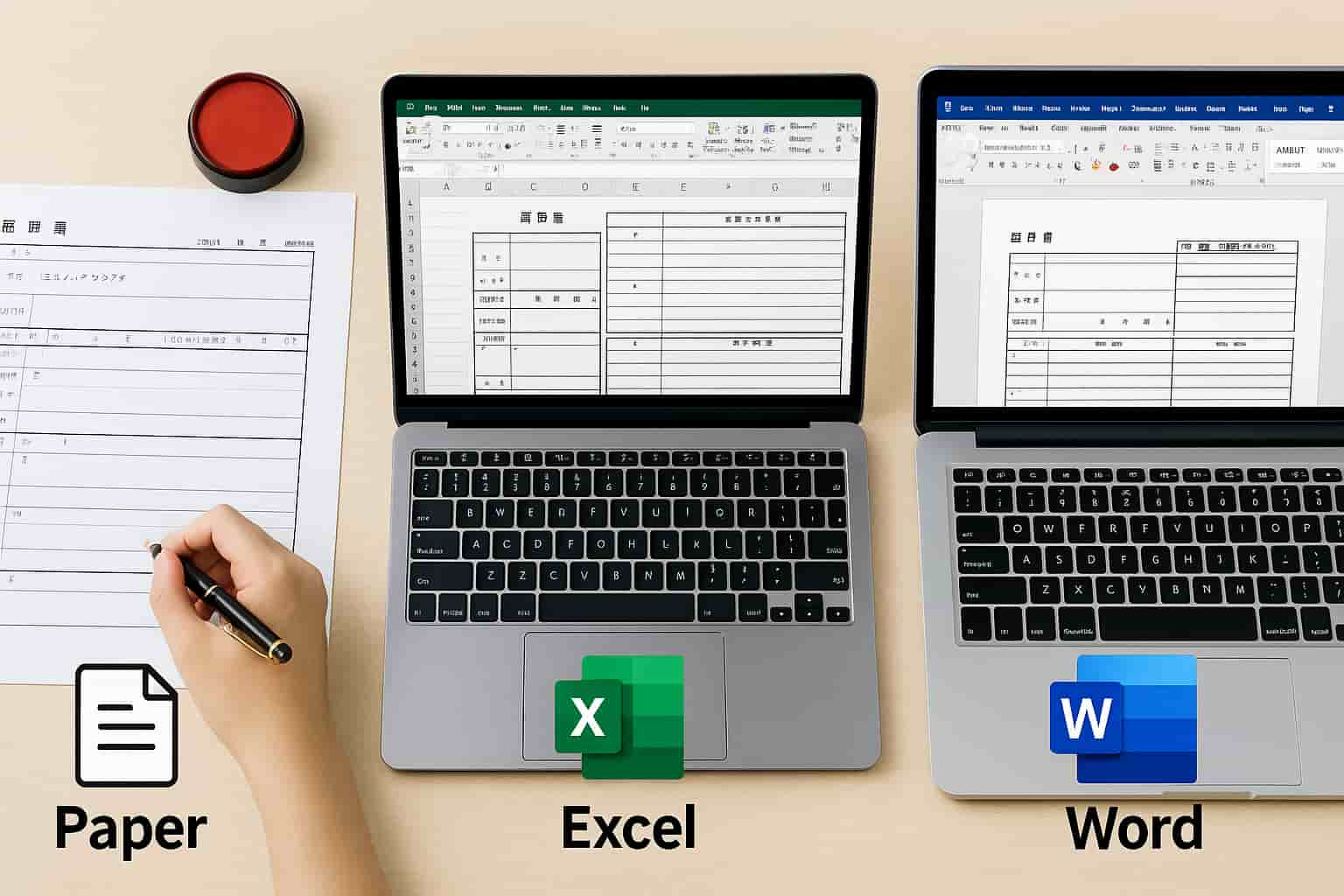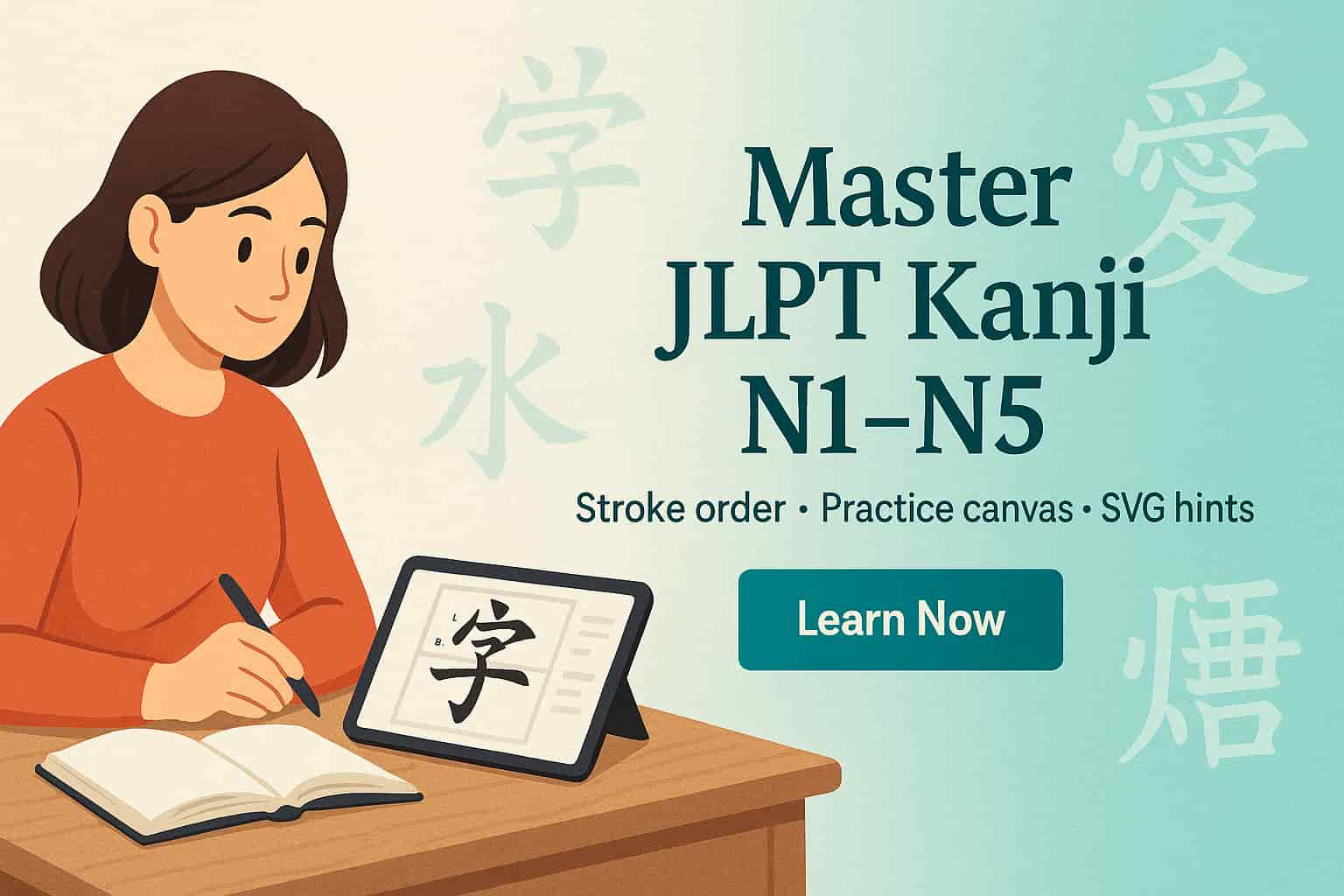Free Rirekisho Templates vs Online Resume Builder: Which Is Better for Foreigners?

If you’re planning to work in Japan, one thing you’ll quickly discover is that almost every job application requires a
Rirekisho (履歴書) — the official Japanese resume.
For many foreigners, especially students or professionals who have just arrived in Japan, this can be confusing.
Western resumes look different from person to person, but the Japanese rirekisho always follows the same format. It often asks for details you may never have been asked before:
a formal ID-style photo, your commute time, or even personal details like marital status.
Imagine you’ve just moved to Japan for studies or your first job search. You’re bright, qualified, and ready to apply ,
but then you hear the word “rirekisho” for the first time. Suddenly, the process feels intimidating because it’s not just a document;
it’s part of Japan’s unique hiring culture.
That brings us to the big question every newcomer eventually asks:
Should you download a free template and try to fill it in manually, or should you use an online resume builder that guides you step by step?
In this article, I’ll walk you through both choices, highlight the real challenges foreigners often face, and show you where each method
makes sense. Whether you decide to stick with a free rirekisho template (Word, Excel, or PDF) or use a smarter online builder,
the goal is simple: to make your life easier and help you focus on getting the job you deserve in Japan.
Understanding the Rirekisho: Why Is It Required in Japan
A Rirekisho (履歴書) is the official Japanese resume that almost every employer in Japan expects as part of a job application.
Unlike Western resumes, which allow creativity and free formatting, the rirekisho follows a strict, standardized style.
The purpose is not to showcase your personality but to present your background in a uniform, easy-to-read format that hiring managers can quickly scan.
Employers in Japan use the rirekisho to verify:
- Basic personal details: Name, age, contact information, and nationality
- Education history: Schools and universities attended in chronological order
- Work history: Previous employers and years of employment
- Qualifications: Language ability, certifications, licenses, or tests passed
- Motivation (志望動機): Why you want to join the company
- Other details: Commute time, availability, and sometimes even marital status

This standardization is the key reason why the rirekisho is required: it allows recruiters to compare hundreds of applicants quickly, side by side, without confusion.
It also reflects Japan’s hiring culture, where attention to detail, effort, and formality matter as much as skills.
For many foreigners, this can feel unusual at first—but understanding why the rirekisho exists helps you see it not just as a form, but as part of Japan’s professional culture.
Non-Japanese Job Seekers Struggle With the Rirekisho
For many foreigners, the first encounter with a Rirekisho (履歴書) feels like stepping into unfamiliar territory.
Back home, resumes are flexible, some people use creative designs, others keep them to one page, and employers expect you to highlight achievements in your own style.
In Japan, however, the rirekisho is the opposite: every box, every line, and even the way dates are written follows a fixed rule.
I still remember my own first experience with it. I had just landed in Japan as a computer science student, sharing a small apartment with my roommate.
To support ourselves, we applied to several part-time jobs, and finally we received our first interview call.
On the phone, the company simply said: “Please bring your rirekisho to the office.”
My friend and I looked at each other completely lost, we had only been in Japan for a week, our Japanese was weak, and this was the first time we had even heard the word rirekisho.
We didn’t know where to get it, how to write it, or even why it was required. That moment was both exciting and stressful, and it showed me how unprepared many foreigners feel in this system.

This kind of situation is common. Many non-Japanese job seekers wonder:
- “Why do I need to include a photo?” In many countries, photos are discouraged to avoid bias, but in Japan, it is a standard expectation.
- “Why do they ask about commute time?” For Japanese companies, punctuality and practicality matter—long commutes can raise concerns about reliability.
- “Why so little space for work experience?” Unlike Western CVs that highlight skills and achievements, the rirekisho is more about facts and consistency; achievements are usually saved for the Shokumukeirekisho (職務経歴書).
This is why many non-Japanese applicants struggle: it’s not about their ability to do the job, but about navigating a document deeply tied to Japan’s work culture.
Understanding this challenge is the first step—and finding the right tools or guidance can make the difference between feeling lost and submitting a resume that truly represents you.
Rirekisho Builders: An Online Solution for Job Seekers
After my first confusing experience with the Rirekisho, I kept thinking: “There has to be an easier way.”
During my college years in Japan, every week we had special job-hunting lectures. As foreign students, these sessions often focused on the rirekisho why it mattered, how to fill in each section, and the common mistakes students made. Week after week, I realized how important this document was for landing a job in Japan, yet how difficult it remained for non-Japanese students.
I still remember sitting in one of those lectures when an idea hit me. As a computer science student, I thought: “Why not create a tool that makes this easier?” At the time, I dreamed of building a Rirekisho Builder as a college project. But between exams, part-time jobs, and limited skills back then, I couldn’t make it happen. Still, the idea never left me it stayed in the back of my mind.
Years later, after graduating and starting my first IT engineer job, I finally had both the knowledge and time to work on it. What began as a dream during college lectures turned into a real project after months of coding and testing. My goal was simple: to make the rirekisho process less stressful and more accessible for everyone, especially foreigners like myself who once struggled with it.

With this online Rirekisho Builder, I tried to keep the system as close as possible to the official rirekisho format, so users can trust that it looks exactly like the real form. At the same time, I added features that make it more user-friendly than paper or Word templates:
- Guided help: Explanations for each section, so you don’t feel lost.
- Smart tools: Postal code search for addresses, automatic age calculation, country selection, and more.
- Cross-device access: Whether you’re on a laptop, desktop, or mobile, you can log in, edit, and download your rirekisho PDF anytime.
- Instant editing: If you notice a mistake, no need to rewrite the whole form, just fix it online and re-download your PDF in seconds.
Imagine being on the way to an interview and realizing you need to update something, if you had filled it out on paper, you’d be stuck. But with this builder, you can edit from your phone and print or send the PDF right away. It’s designed for real-life situations where speed, accuracy, and convenience matter most.
Free Rirekisho Templates: Paper, Excel, and Word Formats
For many foreigners in Japan, the first stop when preparing a Rirekisho is usually a free template. These come in different formats like printed paper, downloadable Excel sheets, or Word documents. Each option has its own advantages, but also challenges that you should be aware of before deciding which one to use.

Paper Templates (Hard Copy)
The most traditional option is to buy a rirekisho form directly from a convenience store or bookstore. They are usually sold in small packs for just a few hundred yen. For Japanese job seekers, this feels normal but for foreigners, it can feel intimidating. You have to handwrite everything neatly in Japanese, and if you make a single mistake, you often need to start over on a brand-new sheet. While handwritten resumes can feel more “personal,” the process can be stressful and time-consuming if you are not confident in your writing skills.Excel Templates
Many websites in Japan provide free Excel versions of the rirekisho. This option is popular because it keeps the standard format while letting you type instead of handwrite. It’s easier to make corrections, and the document looks clean when printed. However, Excel forms can be a little tricky for non-native speakers, Japanese fonts may not display correctly, formatting can break if you’re not careful, and small details like spacing can easily go wrong. For people who are not comfortable with Excel, it can feel frustrating.Word Templates
Word templates are another free choice. They’re slightly more flexible than Excel and feel familiar to many international students or professionals. You can type your details, adjust the size, and print the final version. But the flexibility is also the weakness, because the official rirekisho format is so strict, it’s easy to accidentally change the layout and end up with a version that looks “off” compared to the standard. Japanese recruiters may not accept a rirekisho that looks different from what they expect.So, are free templates useful? Absolutely,they are free, accessible, and give you a way to start your job search in Japan. But they also come with limitations. Paper forms are unforgiving, Excel sheets can be clunky, and Word files may not stay true to the official design. For someone new to Japan, these challenges often lead to wasted time, repeated mistakes, and extra stress. That’s why many foreigners eventually look for an easier, more guided option like an online rirekisho builder.
Key Differences Between Traditional Templates vs Rirekisho Builder Tools
Many foreign job seekers wonder which is easier: sticking with traditional Rirekisho templates, whether paper, Excel, or Word or using an online Rirekisho builder. Based on my own experience, the difference is not just convenience; it can impact your confidence, accuracy, and the time it takes to complete your application.
Traditional templates can feel familiar at first, but they often come with hidden challenges. Paper forms are unforgiving: a single mistake could mean starting over, especially if your Japanese writing isn’t perfect. Excel and Word templates allow typing, but formatting can break easily, Japanese characters may not display correctly, and even minor spacing errors can make your Rirekisho look unprofessional.
Online Rirekisho builders, on the other hand, guide you step by step. They automatically format your information according to official standards, provide helpful tips for each section, and allow quick corrections. One of the biggest advantages is you don’t need to carry your Rirekisho with you all the time. Whenever you need it during job hunting, whether for an interview or submitting a new application, you can simply log in using a laptop or mobile device and access your resume. No stress about forgetting it or making last-minute corrections everything is stored safely online.
Here’s a detailed comparison of traditional templates vs online builders:
| Aspect | Traditional Templates (Paper, Excel, Word) | Online Rirekisho Builder |
|---|---|---|
| Ease of Use | Medium. Requires careful formatting and attention to spacing; paper templates require neat handwriting. | High. Step-by-step guidance reduces mistakes; easy for beginners and foreigners. |
| Editing & Updates | Low. Paper requires re-writing; Excel/Word may require reformatting if mistakes are made. | Very High. Edit anytime online and instantly generate updated PDFs. |
| Formatting Accuracy | Medium. Easy to misalign sections or lose Japanese character formatting. | High. Automatically adheres to official Rirekisho layout, spacing, and font rules. |
| Accessibility | Low to Medium. Requires printer or Excel/Word software; paper forms need physical purchase. | High. Works on laptop, desktop, or mobile; no need to carry a paper copy everywhere. |
| Guidance & Help | Minimal. Templates rarely explain what to write in each section. | High. Built-in explanations and tips help foreigners understand each field. |
| Time Efficiency | Low. Mistakes are time-consuming to correct; paper requires writing from scratch. | High. Tools like auto-calculation, postal code search, and pre-formatted fields save hours. |
| Stress Level | High. Mistakes can be frustrating, especially for first-time users. | Low. Real-time guidance, online storage, and instant corrections reduce stress. |
In my personal experience, using traditional templates during my first part-time job application in Japan was stressful. I remember rewriting paper forms multiple times and trying to adjust spacing in Excel templates—it took hours for something that should have been simple. With an online builder, not only can you fix mistakes instantly, but you also never have to worry about carrying your Rirekisho to every interview. All you need is an internet connection and a device mobile or laptop and your resume is ready to use anytime.
For foreigners unfamiliar with Japanese resume standards, online Rirekisho builders are not just a convenience—they are a practical solution that saves time, reduces mistakes, and gives peace of mind. While traditional templates are still useful, especially for handwritten submissions preferred by some companies, online tools are becoming the most efficient and reliable option for most job seekers.
Which Is the Best Choice for Students and Non-Japanese Job Seekers?
For students and foreigners who are new to Japan, deciding between traditional Rirekisho templates and an online builder can feel overwhelming. From my experience, the main challenges are understanding Japanese resume culture, avoiding formatting mistakes, and managing time during job hunting all while balancing studies or a part-time job.

Let’s break it down:
- Students: If you are still in college or university, you might have limited experience with Japanese resumes. Handwriting a paper Rirekisho can be intimidating, and mistakes can cost you precious time. Excel or Word templates can help, but the risk of formatting errors is still high. Online builders guide you step by step, automatically format your resume, and even provide explanations for each section, perfect for first-time users.
- Non-Japanese Job Seekers: Even if you have work experience abroad, Japanese companies expect the Rirekisho to follow a strict standard. An online builder ensures that all sections personal info, education, employment history, qualifications, and motivation are formatted correctly. It also reduces the risk of small but crucial errors, like incorrect date formats or misaligned spacing, which can make a bad first impression.
Another advantage of online builders is flexibility. As a student or busy professional, you may not always be near a printer or laptop. With an online tool, you can access, edit, and download your Rirekisho anytime, anywhere, using a laptop or even your smartphone. This means last-minute updates before an interview are simple and stress-free, no need to rewrite paper forms or troubleshoot Excel files.
In short, while traditional templates can work for some, an online Rirekisho builder is the safest, most convenient choice for students and non-Japanese job seekers. It helps you:- Save time by reducing formatting errors
- Learn the correct structure of a Japanese resume
- Access your Rirekisho anytime without carrying physical copies
- Stay confident during job applications, interviews, or college recruitment events
Common Mistakes to Avoid When Creating a Rirekisho
Creating a Rirekisho for the first time can be tricky, especially for students or non-Japanese job seekers. Even small mistakes can make your application appear unprofessional or confuse Japanese recruiters. Here are some common pitfalls to watch out for, along with practical tips on how to avoid them:
- Incorrect Formatting: The Rirekisho has a strict structure. Misaligned sections, wrong spacing, or irregular fonts can distract recruiters. Always follow the standard layout: personal information, photo, education, employment history, qualifications, and motivation.
- Handwriting Errors: If you choose a paper template, neat handwriting is crucial. Avoid crossing out mistakes—start a new form if needed. Smudges or unclear characters can create a negative impression.
- Incorrect Dates: Japanese resumes use specific date formats (year/month). Foreign students often accidentally use Western formats or omit important details. Double-check all dates for education and work experience.
- Missing Sections: Every section is important. Skipping items like commute time, expected start date, or motivation can make your Rirekisho incomplete. Even small sections like certifications or language tests matter.
- Photo Mistakes: Your Rirekisho photo should be formal and recent. Casual selfies or poor-quality images are a common mistake. Dress in business attire and ensure good lighting and clarity.
- Poor Japanese Language Use: For non-native speakers, incorrect grammar, spelling, or kanji usage can hurt your application. If unsure, use an online builder with Japanese/English guidance, or ask a friend/professor to review your content.
- Not Updating Information: Some students prepare a Rirekisho early and forget to update it before applying. Always check your education, work history, and contact info before submitting.
- Printing Issues: Excel and Word templates can sometimes cause alignment problems when printed. Test print a copy before submitting, or use a builder that generates print-ready PDFs.
Avoiding these common mistakes may feel overwhelming at first, but tools like online Rirekisho builders can simplify the process. They automatically format sections correctly, provide tips for each field, and let you edit anytime without starting over.
When to Use a Handwritten Rirekisho vs a Printed One
In Japan, the type of Rirekisho you submit can make a subtle but important impression. Both handwritten and printed versions are accepted, but knowing when to use each can help you appear more professional and show attention to detail.
Handwritten Rirekisho:
In Japan, a handwritten Rirekisho is often valued because it shows effort and care. It shows dedication and personal care, especially for positions in small companies, traditional firms, or part-time jobs where formal etiquette is valued.However, for students or non-Japanese job seekers, handwriting can be challenging. Mistakes are difficult to correct, and Japanese characters must be accurate. If your Japanese writing is not strong, a handwritten form could lead to errors that might affect your first impression.
Printed Rirekisho:
Printed or digital Rirekisho created using Excel, Word, or an online builder offers a clean and professional look. For tech-savvy students, office roles, or larger companies, a printed Rirekisho is often preferred. It ensures perfect formatting, legible characters, and can easily be updated if your details change.With an online builder, you can generate a **print-ready PDF** in minutes. You also avoid the stress of rewriting or misaligning sections, and you can store your Rirekisho digitally for anytime access. In short:
- Use handwritten Rirekisho if the company values traditional etiquette or requests it specifically.
- Use printed Rirekisho for most office, tech, or large-company applications, especially if your Japanese writing is not perfect.
- For foreigners and students, online builders are ideal they allow printing, editing, and storing Rirekisho without worrying about handwriting mistakes.
Conclusion: Choose the Best Rirekisho Method for You
Navigating the Japanese job application process can be challenging, especially for students and non-Japanese job seekers. The Rirekisho is not just a resume—it is a cultural standard that reflects professionalism, attention to detail, and respect for Japanese business practices.
From handwritten forms to downloadable templates, and now online Rirekisho builders, there are multiple ways to create your resume. Each has its advantages:
- Handwritten Rirekisho: Shows personal effort and is appreciated in traditional companies or small businesses.
- Paper, Excel, or Word Templates: Free and offline, but prone to formatting errors and time-consuming updates.
- Online Rirekisho Builders: Ideal for foreigners and students. Fast, professional, editable anytime, and accessible from mobile or laptop.
In my own journey—from struggling with my first part-time job application to building a tool that simplifies Rirekisho creation—I realized how much stress can be reduced by using the right method. Online builders not only help you avoid mistakes but also let you focus on what to write, not how to write it. You can access, edit, and download your Rirekisho anytime, anywhere, giving you peace of mind during your job hunt.
Ultimately, the choice depends on your situation and comfort level. But for most students and non-Japanese job seekers, an online Rirekisho builder provides the perfect balance of accuracy, efficiency, and convenience. By using the right tools, you can present a professional, polished Rirekisho that increases your chances of landing your dream job in Japan.
Related Articles & Resources
If you want to learn more about job hunting in Japan, visas, or finding opportunities as a foreigner, check out these helpful articles:
- How I Found My First Web Developer Job in Japan Without Speaking Japanese
- Jobs in Japan Without Japanese: Everything You Need to Know
- The Best Job Portals for Foreigners in Japan (Free, Paid & Developer Platforms)
- Top 10 Companies Hiring Foreigners in Japan Right Now
- Japan Work Visa Requirements: What You Need to Know
These articles will give you more insights on finding jobs, understanding visa requirements, and navigating the Japanese job market as a foreigner.
